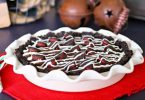Buttermilk stands out in culinary use for its distinct tangy flavor and its ability to make cakes moist and fluffy. In case you’re out of buttermilk, you may be seeking alternatives for baking purposes.
Continue reading to uncover the finest choices!

Buttermilk is a key player in baking recipes, though it’s not always available at home.
This guide highlights 14 diverse buttermilk substitutes for your baking needs, ranging from dairy and non-dairy to low-carb options.
First up, let’s delve into dairy-based alternatives to buttermilk in baking.
8 Dairy-Based Alternatives to Buttermilk
For those who can’t do without dairy in baking, here are some dairy-based options: milk with vinegar, milk with lemon juice, milk with cream of tartar, lactose-free milk with an acid, sour cream diluted with water or milk, plain yogurt thinned with water or milk, plain kefir, and buttermilk powder mixed with milk.
Next, let’s explore the combination of milk and vinegar.
1. Milk and Vinegar

Milk combined with vinegar forms a superb dairy-based alternative to buttermilk in baking.
Vinegar, rich in lactic acid found in commercial buttermilk, ferments the milk, endowing it with the necessary leavening properties for cake recipes.
Choose between apple cider vinegar for a distinct taste or distilled white vinegar for a more neutral flavor.
Here’s how you mix milk with vinegar to mimic buttermilk:
- Mix 1 tablespoon of vinegar with 1 cup of milk for a cup of buttermilk.
- First pour the vinegar, then add milk until the 1 cup mark is reached.
- Blend thoroughly.
- Let it rest for 5-10 minutes or use right away.
Up next, let’s examine the blend of milk and lemon juice.
2. Milk and Lemon Juice

Milk and lemon juice together create a fantastic baking substitute for buttermilk. It’s akin to the vinegar mix, as lemon juice shares similar properties.
Prefer fresh lemon juice for optimal flavor, but bottled lemon juice is also viable, barring considerations for asthmatics due to certain preservatives.
Follow these steps to make a buttermilk-like mixture with milk and lemon juice:
- Add 1 tablespoon of lemon juice to a cup, then fill with milk to make 1 cup.
- Stir the ingredients well.
- Use as required in your baking recipes.
Coming up, let’s look at milk combined with cream of tartar.
3. Milk and Cream of Tartar

Milk mixed with cream of tartar serves as a great baking substitute for buttermilk.
Cream of tartar, also known as potassium bitrate, is a neutral-flavored acid produced during winemaking.
Here’s how to create a buttermilk alternative with milk and cream of tartar:
- Mix 1 ¾ tablespoons of cream of tartar with 1 cup of milk.
- To avoid clumping, mix the cream of tartar with the dry ingredients or blend it with a small amount of milk first.
- Then, incorporate it into the remaining milk.
Next, let’s discover the use of lactose-free milk and acid.
4. Lactose-Free Milk and Acid

Lactose-free milk with an acid is an excellent buttermilk alternative for baking.
It’s especially suitable for lactose-intolerant individuals, offering a sweeter, palatable version of buttermilk.
Here’s the method to make a buttermilk substitute with lactose-free milk and acid:
- Start with 1 tablespoon of vinegar or lemon juice in a cup.
- Add lactose-free milk to make 1 cup.
- Stir until well mixed.
- Ready to use in your baking recipes.
Let’s now look at sour cream mixed with water or milk.
5. Sour Cream and Water or Milk

Sour cream combined with water or milk is another viable buttermilk substitute for baking.
Sour cream, made by adding lactic acid to cream, shares the tangy profile of buttermilk. To match buttermilk’s consistency, dilution is needed.
To mimic buttermilk with sour cream and water or milk, follow these steps:
- Use ¾ cup of sour cream and ¼ cup of water or milk for each cup of buttermilk needed.
- Whisk until the mixture is smooth and fluid.
- Then use it as required in your baking recipes.
You can also use buttermilk in place of sour cream in baking.





